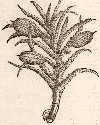
 |
Stirpium adversaria nova: perfacilis vestigatio, luculentaqne [sic] accessio ad priscorum, presertim Dioscoridis & recentiorum, materiam medicam: quibus propediem accedet altera pars: qua conjectaneorum de plantis appendix, de succis medicatis et metallicis sectio, antiquae & novatae medicine lectiorum remediorum thesaurus opulentissimus, de succedaneis libellus continentur.
Londini: Excudebat prelum Thomas Purfoetii, 1570 [i.e. 1571]. Colophon: Londoni. 1571. Calendis Januariis, excudebat prelum Thomae Purfoetii, ad Lucretie symbolum. . . References: STC 19595; Johnston, S. H. Clevland coll. 103. Contains three additional woodcuts, inserted to face p. 11, 33, and 150. Reissued (with additional matter) by Christophe Plantin of Antwerp in 1576, with L'Obel's Plantarum seu stirpium historia, under title: Nova stirpium adversaria. . .. Purfoot's 1570 ed. [1571].
This work has been heralded as a significant landmark in the history of classification, and de L'Obel is ranked among the greatest botanists of the 16th century. Unfortunately, scholars do not know what part was played by Pierre Pena in the publication of this work, and it is believed that he abandoned botany in favor of medicine. Although Pena's name appears first on the title page of this edition, it is still commonly referred to as de L'Obel's primary botanical work. At the time of publication, this edition sold so few copies that its publisher, Thomas Purfoot, sold many of the leftover sheets to other publishers who supplied new title pages or used the pages to add to works by other authors. As a result, this particular edition became quite rare. De L'Obel was the favorite pupil of physician and naturalist Guillaume Rondelet. Upon his death in 1566, Rondelet bequeathed his botanical manuscripts to de L'Obel. De L'Obel and his friend Pena decided to publish a joint botanical work based on these materials. They left France and traveled to England to have it published, because English scholarship and publishing were then prospering under the rule of Elizabeth I. They traversed the British Isles and incorporated in their writings plants that had not been known to William Turner. De L'Obel's Latin was considered "barbarous," but his textual material was substantive. His system of classification is more advanced than those used by other contemporary botanists; arrangement is based mainly on difference of leaf characteristics. In this work, A New Daybook on Plants, de L'Obel states his belief that plant classification could reveal the underlying unity of all forms of life. He writes of this vision of a "universal order" where "things which are far and widely different become, as it were, one thing." The Lobelia plant was named for him.
Subjects: Plant classification; Botany.
PAT-132